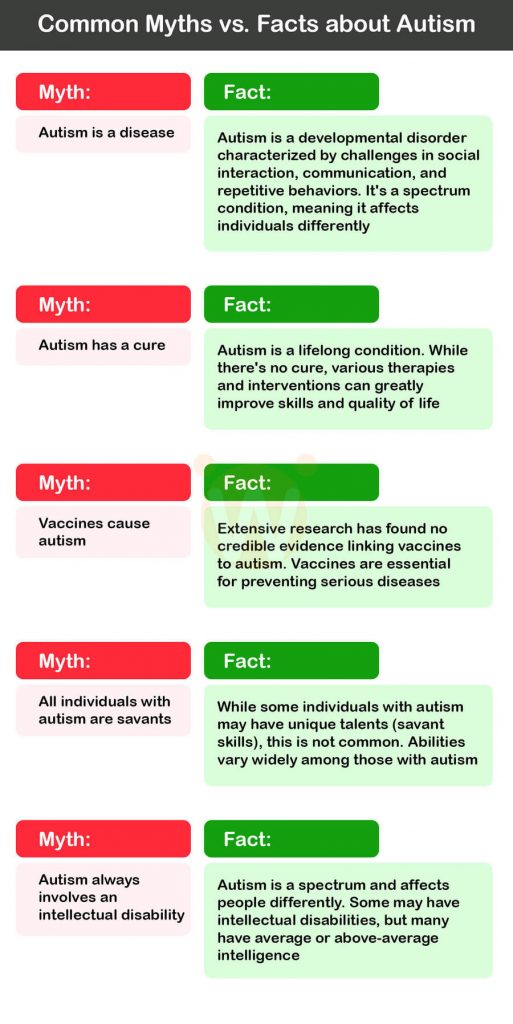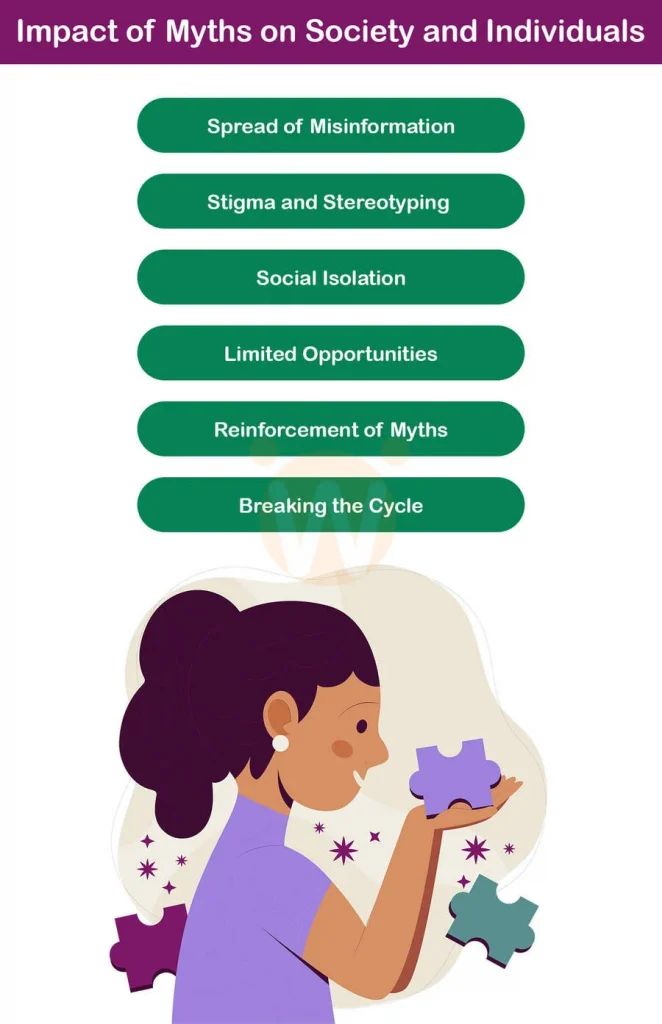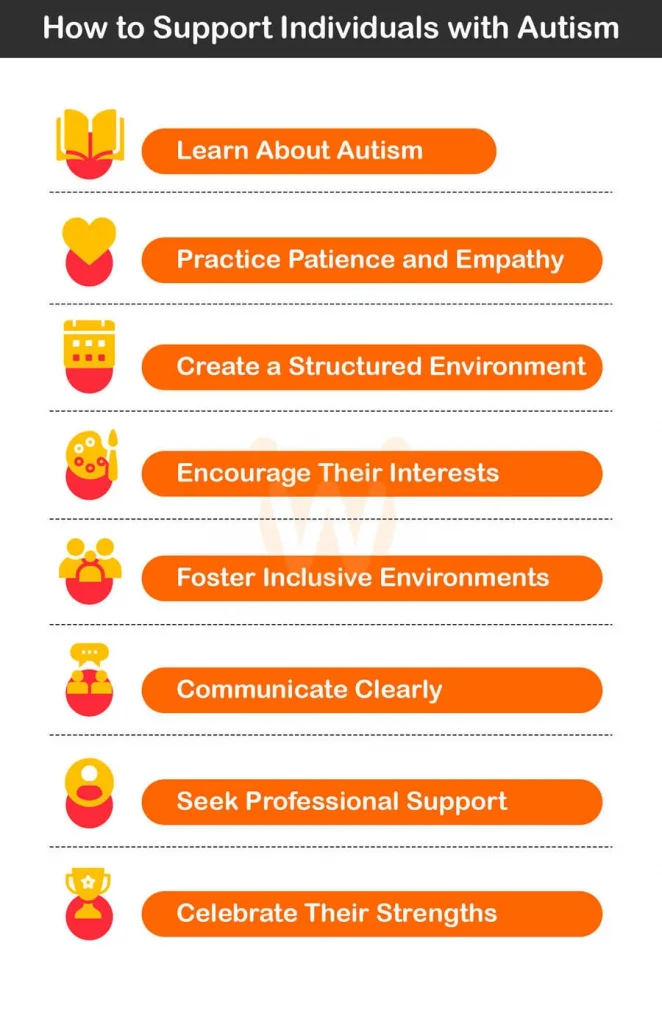Busting Common Myths About Autism: What You Need to Know
By Rajini D
Last Updated: February 7, 2024
Autism Spectrum Disorder (ASD) is a term that many of us have heard, but how much do we really understand about it? Around the world, autism is surrounded by a variety of myths and misconceptions that can lead to confusion and misunderstanding. From unfounded causes to exaggerated abilities, these myths do more than spread misinformation – they can significantly impact the lives of those on the spectrum and their families.
Our goal is straightforward yet crucial: to bust the common myths about Autism Spectrum Disorder. We’re here to separate fact from fiction, providing you with accurate and up-to-date information. Whether you’re a parent, educator, healthcare professional, or simply someone keen to learn more, this article is for you. We aim to dispel the misunderstandings and shed light on what autism really is, helping to foster a more informed and empathetic understanding of the condition.
For more insights into developmental conditions, explore our comprehensive guide on Early Identification Warning Signs in Child Development.
Understanding Autism Spectrum Disorder (ASD)
Autism Spectrum Disorder, or ASD, is like a rainbow – varied, colorful, and a little different each time you look at it. It’s a complex developmental condition that includes a range of symptoms and abilities. People with ASD often experience challenges with social interaction and communication and sometimes exhibit repetitive behaviors. But that’s just the tip of the iceberg.
The word ‘spectrum’ in ASD is crucial. It means that no two people with autism are exactly alike – they can be as different from each other as any two people without autism. Some might need significant support in their daily lives, while others might live entirely independently. You might meet individuals with ASD who are non-verbal and others who are very articulate. Some may have exceptional abilities in areas like music, art, or memory, while others might not.
This diversity is what makes understanding autism a unique challenge. It’s not a one-size-fits-all situation; each person with ASD has their own set of strengths and challenges. It’s like having a box of crayons – each color is distinct and beautiful in its own way, and together, they create a vibrant spectrum.
Discover more about the colorful spectrum of ASD in our detailed piece on Autism Color Impact Guide.
Benefits of Early Intervention in Autism Spectrum Disorder
| Aspect of Development | Benefits of Early Intervention |
|---|---|
| Communication Skills | Improves both verbal and non-verbal communication abilities, enhancing interaction with others. |
| Social Skills | Increases ability to form relationships, understand social cues, and engage in social activities. |
| Behavioral Challenges | Reduces negative behaviors and helps develop positive coping strategies. |
| Cognitive Abilities | Enhances learning skills, problem-solving abilities, and overall cognitive development. |
| Emotional Development | Aids in recognizing and expressing emotions in a healthy way, improving emotional regulation. |
| School Readiness | Prepares children for the school environment, promoting academic success and easier integration. |
| Family Dynamics | Helps families understand and effectively respond to the needs of their child with ASD, improving overall family life. |
| Long-Term Independence | Increases the likelihood of independence in adulthood through skill development and self-care abilities. |
Learn about the various Therapies Offered to Autistic Patients and their benefits.
Debunking Common Myths

As we embark on a journey to understand Autism Spectrum Disorder (ASD) better, it’s crucial to clear the air of myths that often cloud our perceptions. Let’s address some of the most common myths about autism and shed light on the facts.
Myth #1: Autism is a Disease
The Truth: Autism is not a disease; it’s a developmental disorder. This means it’s about growth and development, not an illness that can be ‘cured’ or ‘caught.’ People with autism experience the world differently due to differences in their brain development. This distinction is vital to understanding their needs and how we can support them effectively.
Myth #2: Autism Has a Cure
The Truth: Autism is a lifelong condition. While there’s no ‘cure’ in the traditional sense, various therapies and interventions can make a huge difference. Speech therapy, occupational therapy, and behavioral interventions can help those with autism lead fulfilling lives. The key is not to aim for a ‘cure’ but to provide support and resources for growth and learning.
Myth #3: Vaccines Cause Autism
The Truth: This myth has been debunked time and again by extensive research. There’s no scientific evidence linking vaccines to autism. Vaccines are crucial for preventing serious diseases and do not affect a child’s neurological development. By vaccinating, we protect not only individual health but also public health.
For a deeper understanding, read our article on The Speech Chain, which discusses communication challenges in ASD.
Myth #4: All Autistic Individuals are Savants
The Truth: The portrayal of autistic individuals in media as ‘savants’ with extraordinary talents in math, art, or memory is a misconception. While some individuals on the spectrum may have unique abilities, most do not. Autism is diverse, and so are the abilities of those with ASD.
Myth #5: Autism Equals Intellectual Disability
The Truth: Autism and intellectual disability are not synonymous. Many individuals with autism have average or above-average intelligence. Autism primarily affects communication and social interaction, and while some may have intellectual disabilities, it’s not a given for everyone with ASD.
Impact of Myths on Society and Individuals

Myths and misconceptions about Autism Spectrum Disorder (ASD) aren’t just harmless tales; they have real-world consequences. For individuals with ASD and their families, these myths can create barriers to acceptance, understanding, and support. Let’s take a closer look at how these myths can shape realities.
In many parts of the world, including countries like Nigeria, myths about autism can lead to stigma and social isolation. Families may face judgment and lack of support, not only from their communities but sometimes even from their own extended families. This can make navigating the challenges of ASD even more daunting.
For individuals with autism, these myths can translate into limited opportunities – in education, employment, and social interactions. The misconception that autism is always associated with intellectual disability, for instance, might lead educators or employers to underestimate an individual’s capabilities.
Moreover, the myth that individuals with ASD are not interested in forming social relationships can lead to social exclusion, further complicating their efforts to connect with others. The reality is often quite the opposite – many people with autism desire social connections but may approach them differently.
To understand more about social challenges, check out Social Medias Impact on Relationships Explained.
The Role of Awareness and Advocacy
This is where the power of awareness and advocacy comes in. By dispelling myths and spreading accurate information, we can foster a more inclusive and empathetic society. Awareness brings understanding, and understanding brings acceptance.
At Wellness Hub, we are deeply committed to this cause. We believe that awareness is the first step toward change. Through our resources and support, we aim to educate and empower not just individuals with ASD and their families but also the wider community. By providing accurate information and dispelling myths, we strive to create a world where everyone, regardless of their neurological makeup, is valued and included.
Together, we can work towards a society that not only understands autism but also appreciates the unique perspectives and talents that individuals on the spectrum bring to our world.
Gain historical insights from our article on the History of Autism.
How to Support Individuals with Autism

Supporting someone with Autism Spectrum Disorder (ASD) is not just about understanding their condition but also about embracing their individuality. Everyone on the autism spectrum is unique, and their needs can vary greatly. Here are some practical ways to offer support and create an inclusive environment for individuals with autism.
Learn About Autism: Knowledge is the first step towards understanding. Take time to learn about autism and its effects on social interaction, communication, and behavior. Websites like Wellness Hub offer valuable resources for learning about ASD.
Practice Patience and Empathy: Individuals with autism may communicate and interact in ways that are different from what they’re used to. Be patient and empathetic. Try to see the world from their perspective and appreciate their method of expressing themselves.
Create a Structured Environment: Many people with autism thrive in structured environments. Consistency and routine can help reduce anxiety and uncertainty. If you’re a parent, teacher, or caregiver, establishing a predictable routine can be incredibly beneficial.
Encourage Their Interests: Many individuals with autism have specific areas of interest. Encourage these passions, as they can be a source of joy, relaxation, and expertise.
Foster Inclusive Environments: Whether it’s at school, work, or in social settings, strive to create environments where individuals with autism feel included and valued. This means making accommodations when necessary and educating others about autism.
Communicate Clearly: Clear, straightforward communication is often appreciated by those with autism. Avoid using figurative language or sarcasm, which can be confusing. Be direct and concise in your interactions.
Seek Professional Support: Don’t hesitate to seek help from professionals like speech therapists, occupational therapists, and behavioral therapists. These experts can provide guidance and support tailored to the individual’s needs.
Celebrate Their Strengths: Focus on the strengths and abilities of the individual with autism, not just the challenges. Celebrate their successes, no matter how small they may seem.
For specific parenting tips, read Tips for Parenting an Autistic Child.
Therapies and Interventions for Autism Spectrum Disorder
| Type of Therapy/Intervention | Description | Goal |
|---|---|---|
| Behavioral Therapies | Includes Applied Behavior Analysis (ABA), Cognitive Behavioral Therapy (CBT), and others focusing on behavior modification. | To improve social skills, communication, and learning abilities by reinforcing positive behaviors. |
| Speech and Language Therapy | Focuses on improving communication skills, both verbal and non-verbal. | To enhance the ability to express and understand language. |
| Occupational Therapy | Helps individuals develop skills needed for daily living and independence. | To improve sensory integration, motor skills, and cognitive abilities. |
| Physical Therapy | Involves exercises and activities to improve motor skills and physical fitness. | To enhance physical strength, coordination, and mobility. |
| Social Skills Training | Group or individual sessions aimed at improving social interaction skills. | To facilitate better interaction with others and understanding social cues. |
| Special Education Programs | Tailored educational programs in school settings to meet individual learning needs. | To provide an adapted learning environment for educational success. |
| Play Therapy | Uses play to communicate with and help children express their feelings. | To enhance emotional and social development through structured play. |
| Family Therapy | Involves family members in therapy sessions to improve understanding and support. | To strengthen family dynamics and provide support for coping and managing ASD. |
Explore Speech Therapy for Autism to understand how it can aid in development.
Conclusion
Autism is not a disease but a developmental spectrum, and understanding this helps us approach it with empathy and support. Debunking myths about autism is crucial — it not only aids those with ASD but also enriches our society with diversity and inclusion.
For further reading on nurturing relationships, visit our Relationship Counseling Online page.
Awareness and correct information are powerful tools. By educating ourselves and sharing what we learn, we contribute to a more understanding world. At Wellness Hub, we’re dedicated to this cause, offering resources and support to those touched by autism.
Let’s all do our part in spreading knowledge and fostering acceptance. Every effort counts in building an inclusive community where everyone’s unique strengths are celebrated.
Frequently Asked Questions:
1. What is Autism Spectrum Disorder (ASD)?
Autism Spectrum Disorder is a developmental condition characterized by challenges with social interaction and communication and often includes repetitive behaviors. The term ‘spectrum’ reflects the wide variation in challenges and strengths possessed by each person with autism.
2. Can Autism Spectrum Disorder be cured?
There is no cure for Autism Spectrum Disorder as it is a lifelong condition. However, various therapies and interventions can significantly improve the skills and abilities of someone with ASD, helping them lead a fulfilling life.
3. Do vaccines cause autism?
Extensive research has found no credible evidence linking vaccines to Autism Spectrum Disorder. Vaccines are crucial for preventing serious diseases and do not impact a child’s neurological development.
4. Are all individuals with autism savants?
While some individuals with autism may have unique talents or savant skills, this is not the case for everyone with ASD. Autism affects people in different ways, with a range of abilities and strengths.
5. Is Autism Spectrum Disorder a type of intellectual disability?
Autism Spectrum Disorder and intellectual disability are different. While some individuals with autism may have intellectual disabilities, many have average or above-average intelligence.
6. How can I support someone with Autism Spectrum Disorder?
Supporting someone with autism involves learning about the condition, practicing patience and empathy, creating structured environments, and encouraging their interests. It’s also important to communicate clearly and seek professional support when needed.
7. What are some common myths about autism?
Common myths include the beliefs that autism is a disease, has a cure, is caused by vaccines, or that all individuals with autism are savants. Another myth is that autism is always associated with intellectual disability.
8. Why is awareness about autism important?
Raising awareness about autism is crucial for fostering understanding, acceptance, and inclusion of individuals with ASD in society. It helps break down myths and misconceptions, leading to better support and opportunities for those on the spectrum.
9. What are the early signs of Autism in children?
Early signs of Autism in children can include delayed speech, limited social interaction, repetitive behaviors, and unusual responses to sensory stimuli. These signs can vary greatly among children.
10. Why is an inclusive environment important for individuals with autism?
An inclusive environment acknowledges and supports the unique needs of individuals with autism, helping them participate fully in society and utilize their talents and abilities.
About the Author:
Rajini, Speech-Language Pathologist:
Rajini is a dedicated Speech-Language Pathologist with a focus on developmental speech and language disorders in children and rehabilitation in adults. With a passion for helping each individual find their voice, Rajini brings a wealth of experience and a heartfelt approach to therapy. At Wellness Hub, she’s part of a team that values innovation, compassion, and results-driven practices.
Book your Free Consultation Today
Parent/Caregiver Info:
Client’s Details:
* Error Message









